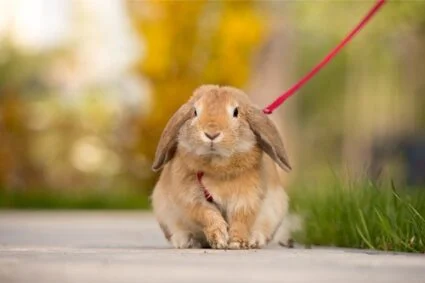Rabbits are free-running and skittish animals, constantly checking for danger and fleeing when they sense it. So, rabbits will dislike being walked like other kinds of pets.
The instinct of rabbits is to roam free. Nervous or injured rabbits may permit being walked on a harness. A harness is safer than a collar because it provides an even distribution of weight.
Before your rabbit will be prepared to wear a harness, you will need to train it. This could be a lengthy process, but harness training can be pivotal to rehabilitation following an injury.
Can Bunny Rabbits Wear Collars?
In theory, you could attach a lead to a collar and take your rabbit for a walk. This could be a great way to encourage your rabbit to exercise.
There are several risks associated with rabbit collars, though. If you plan to attach a collar to your rabbit, follow these guidelines.
- Never force your rabbit to wear a collar. If it refuses to do so, you must accept its decision.
- Pick a collar that’s the right size. Your rabbit must be able to breathe, but don’t leave enough space for it to slip the collar.
- Never jerk the leash while your rabbit is wearing a collar. Rabbits have brittle, delicate bones.
- Ensure that the leash is long and extendable. Your rabbit may binky or run unexpectedly while on a collar. This could result in strangulation.
- Never tie the leash to an inanimate object and leave your rabbit unattended.
- Watch to ensure it does not get the collar trapped on a foreign object.
There are some benefits. You can attach contact information to a collar, for example. That way, if your rabbit ever escapes, you can be notified if it is found.

Can Rabbits Wear Harnesses?
Harnesses are safer for a rabbit than a collar. A harness creates an even distribution of weight throughout a rabbit’s body. If you need to move a harnessed rabbit quickly, she won’t hurt itself.
A rabbit harness will be fastened by Velcro or buckles. As with a collar, the fit is important. You should be able to fit two fingers beneath the harness. Don’t leave it too loose or she may escape. Your rabbit will flee, and be nigh on impossible to keep up with.
A harness is most often used for agility training, according to the Minnesota Companion Rabbit Society. Some rabbits adore agility training, but others refuse to engage.
If you are planning on exercising your rabbit on a leash, always use a harness. Train it first, though. Wearing a harness will not come naturally to your rabbit. It’ll need some time to get used to it.
How to Harness Train a Rabbit
If you plan to walk your rabbit on a leash, you’ll need to train it first. This will take a long time. Your rabbit is unlikely to ever stroll alongside you in a straight line, matching your pace.
The first step to training is introducing your rabbit to its harness. Lay it on the floor, and let it approach. If it wants to play with the harness, that’s fine. If it’s indifferent, add a light dusting of an appealing scent.
Pretty soon, your rabbit will grow indifferent to the sight of its harness. The next challenge is convincing it to wear it. Affix the harness, making a fuss all the while. Give your rabbit a favorite treat, and leave it wearing the harness for about twenty minutes.
Don’t try to walk it just yet. For the first few days of training, just get your pet used to wearing the harness. This will tell you if your rabbit will ever accept it. If it is chewing and struggling after a few days, it’s best to give up. You’re just going to prolong your rabbit’s distress.
When you’re ready, attach a leash and start walking your rabbit indoors. Every once in a while, give the gentlest tug possible. This is establishing the give-and-take nature of walking on a leash.
Once your rabbit is leash trained in the house, you can upgrade to walking around the backyard. This way, your rabbit will have a greater surface area to cover. It can also eat grass and, most importantly, build its confidence.

Should I Be Taking My Rabbit for a Walk?
Most rabbits do not enjoy being walked on a leash. Rabbits are independent animals. All the same, attaching a leash to a harness and walking your rabbit could be useful. If you have a nervous rabbit, it may be the only way to exercise it. Your rabbit may become braver.
Your rabbit may need some physical rehabilitation. Sickness or injury can leave rabbits feeling lethargic. To encourage your rabbit to get physical again, an accompanied walk may be necessary.
If you decide to start walking your rabbit, never take it out in the street. There are a number of dangers associated with taking rabbits outside:
- All the sights, sounds, and smells of the great outdoors may overwhelm your rabbit. This will cause it to panic.
- If your rabbit decides that it enjoys being outside, it’ll grow excitable. This could lead to her slipping its harness and escaping. It may have a new determination to bust out of its hutch.
- Danger is everywhere for a rabbit. Neighborhood dogs and cats could emerge from seemingly anywhere, as can wild birds.
- Eventually, your rabbit’s curiosity will take over. It will want to explore this brave new world at its own pace. If it strains and pulls on the lead, it could hurt herself.
- Rabbits are not vaccinated against disease by law, and have weak immune systems. Rabbits could contract countless diseases or viruses while roaming the streets.
- Rabbits explore the world through their mouths. Your pet will lick and eat all kinds of dangerous things. These could cause a fatal intestinal blockage.
Walking a rabbit on a leash should always be a temporary solution. Your rabbit will want to run free eventually. You need to encourage this behavior. It’ll always get more exercise this way. It just may take a while to get it there.
Rabbits have evolved to be free-running animals. This is how they live in the wild. A rabbit needs to know that it can flee to safety at the first sign of danger. This instinct is hardwired into domesticated rabbits too.

